Provision with the Terraform Apply step
This topic describes how to apply a Terraform plan or script using the Terraform Apply step.
The Terraform Apply step can apply a Terraform script with or without the Terraform Plan step.
Typically the Terraform Apply step is used with the Terraform Plan step to apply a plan. For steps on using the Terraform Plan step, see Plan Terraform Provisioning with the Terraform Plan Step.
The Terraform Apply step can provision any resource, including the target infrastructure for a CD deployment. For steps on provisioning the target infrastructure for a CD deployment, see Provision Target Deployment Infra Dynamically with Terraform.
Before you begin
Install Terraform on delegates
Terraform must be installed on the Delegate to use a Harness Terraform Provisioner. You can install Terraform manually or use the INIT_SCRIPT environment variable in the Delegate YAML.
See Build custom delegate images with third-party tools.
# Install TF
microdnf install unzip
curl -O -L https://releases.hashicorp.com/terraform/1.3.5/terraform_1.3.5_darwin_amd64.zip
unzip terraform_1.3.5_darwin_amd64.zip
mv ./terraform /usr/bin/
# Check TF install
terraform --version
Terraform Plan and Apply steps
Typically the Terraform Plan step is used with the Terraform Apply step.
First, you add the Terraform Plan step and define the Terraform script for it to use.
Next, you add the Terraform Apply step, select Inherit from Plan in Configuration Type, and reference the Terraform Plan step using the same Provisioner Identifier.
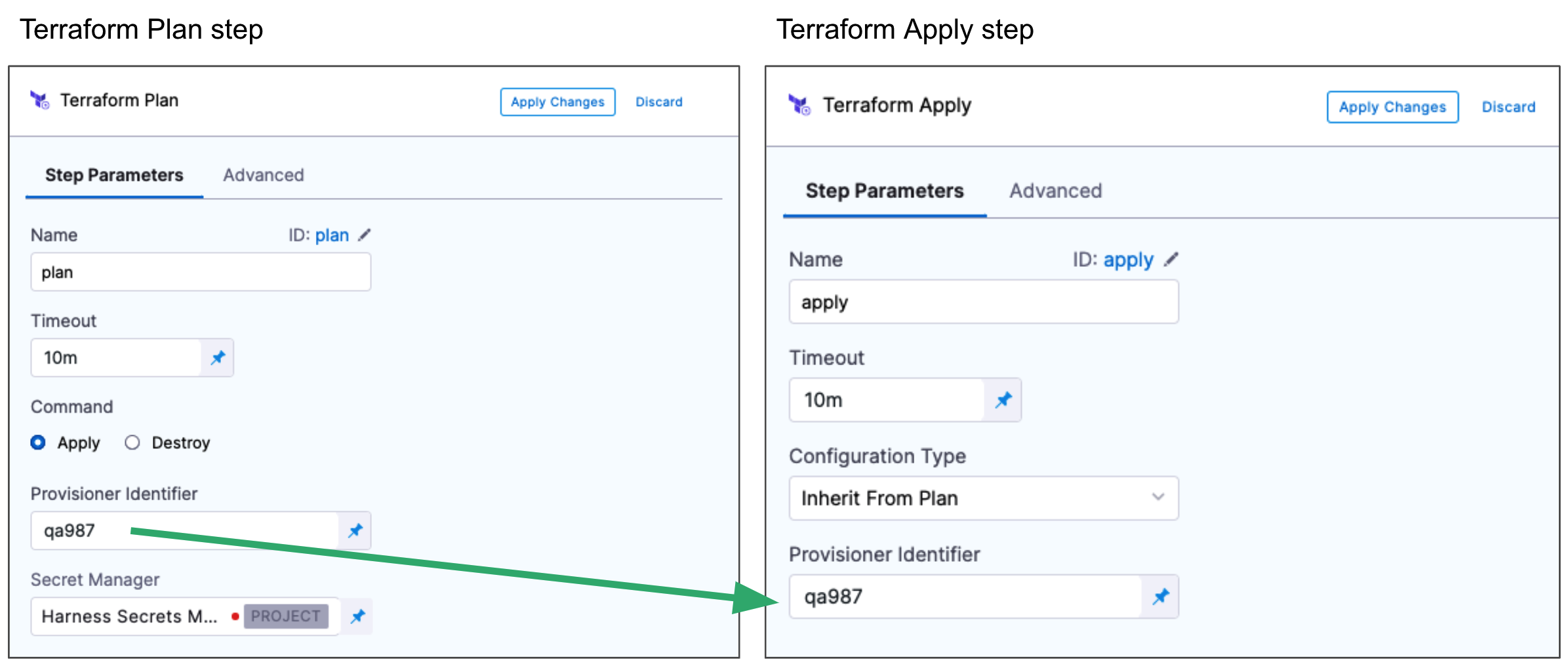
Currently, Configuration Type cannot be set to Inherit from Plan if the Run on Remote Workspace checkbox is checked.
For steps on using the Terraform Plan with the Apply step, see:
You can also simply run the Terraform Apply step without applying the plan from the Terraform Plan step.
In that case, you simply add the Terraform Apply step and select the Inline option in Configuration Type. Next, you add the Terraform script and settings in Terraform Apply. This scenario is described below.
Add the Terraform Apply step
When you are provisioning the target infrastructure for a deployment, you add the Terraform Plan step in the stage's Infrastructure in Dynamic Provisioning. Dynamic Provisioning is used to provision the target infrastructure for the stage's deployment. Consequently, if you add Terraform Plan there, you must use a Terraform Apply step to apply the plan.
See Provision Target Deployment Infra Dynamically with Terraform.
You can also add a Terraform Apply step anywhere in the Execution steps for the stage. In that case, you can use a Terraform Plan step but it's not required.
When you use the Terraform Apply step without using the Terraform Plan step, you set up the Terraform Apply step to connect Harness to your repo and add Terraform scripts.
The Terraform Apply step has the following settings.
Name
In Name, enter a name for the step, for example, apply.
The name is very important. You can use the name in expressions to refer to settings in this step.
For example, if the name of the stage is Terraform and the name of the step is apply, and you want to echo its timeout setting, you would use:
<+pipeline.stages.Terraform.spec.execution.steps.apply.timeout>
or simply <+execution.steps.apply.timeout>.
Timeout
In Timeout, enter how long Harness should wait to complete the Terraform Apply step before failing the step.
Run on remote workspace
Enable this option to identify whether the Terraform configuration uses a Terraform remote backend.
When enabled, you cannot provide the workspace input in Harness. The workspace will be outlined in your configuration for the remote backend.
Also, the remote backend is supported only when the Configuration Type is Inline.
terraform {
backend "remote" {
hostname = "app.terraform.io"
organization = "your-organization"
workspaces {
name = "your-workspace"
}
}
}
Configuration type
In Configuration Type, select Inline or Inherit from Plan.
If you select Inherit from Plan, you'll enter the unique Id used by a Terraform Plan step in Provisioner Identifier.
If you select Inline, you'll configure this Terraform Apply step to use a Terraform script without any Terraform Plan step.
We'll cover the Inline settings below.
Provisioner identifier
Enter a unique value in Provisioner Identifier.
The Provisioner Identifier identifies the provisioning done in this step. You use the Provisioner Identifier in additional steps to refer to the provisioning done in this step.
The most common use of Provisioner Identifier is between the Terraform Plan and Terraform Apply steps. For the Terraform Apply step, to apply the provisioning from the Terraform Plan step, you use the same Provisioner Identifier.

You also use the same Provisioner Identifier with the Terraform Destroy step to remove the provisioned resources.

You also use the same Provisioner Identifier with the Terraform Rollback step to rollback the provisioned resources.
Provisioner identifier scope
The Provisioner Identifier is a Project-wide setting. You can reference it across Pipelines in the same Project.
For this reason, it's important that all your Project members know the Provisioner Identifiers. This will prevent one member building a Pipeline from accidentally impacting the provisioning of another member's Pipeline.
Configuration file repository
Configuration File Repository is where the Terraform script and files you want to use are located.
Here, you'll add a connection to the Terraform script repo.
Click Specify Config File or edit icon.
The Terraform Config File Store settings appear.
Click the provider where your files are hosted.

Select or create a Connector for your repo. For steps, see Connect to a Git Repo, Artifactory Connector Settings Reference or AWS Connector Settings Reference.
Git
In Git Fetch Type, select Latest from Branch or Specific Commit ID. When you run the Pipeline, Harness will fetch the script from the repo.
Specific Commit ID also supports Git tags. If you think the script might change often, you might want to use Specific Commit ID. For example, if you are going to be fetching the script multiple times in your Pipeline, Harness will fetch the script each time. If you select Latest from Branch and the branch changes between fetches, different scripts are run.
In Branch, enter the name of the branch to use.
In Folder Path, enter the path from the root of the repo to the folder containing the script.
For example, here's a Terraform script repo, the Harness Connector to the repo, and the Config Files settings for the branch and folder path:
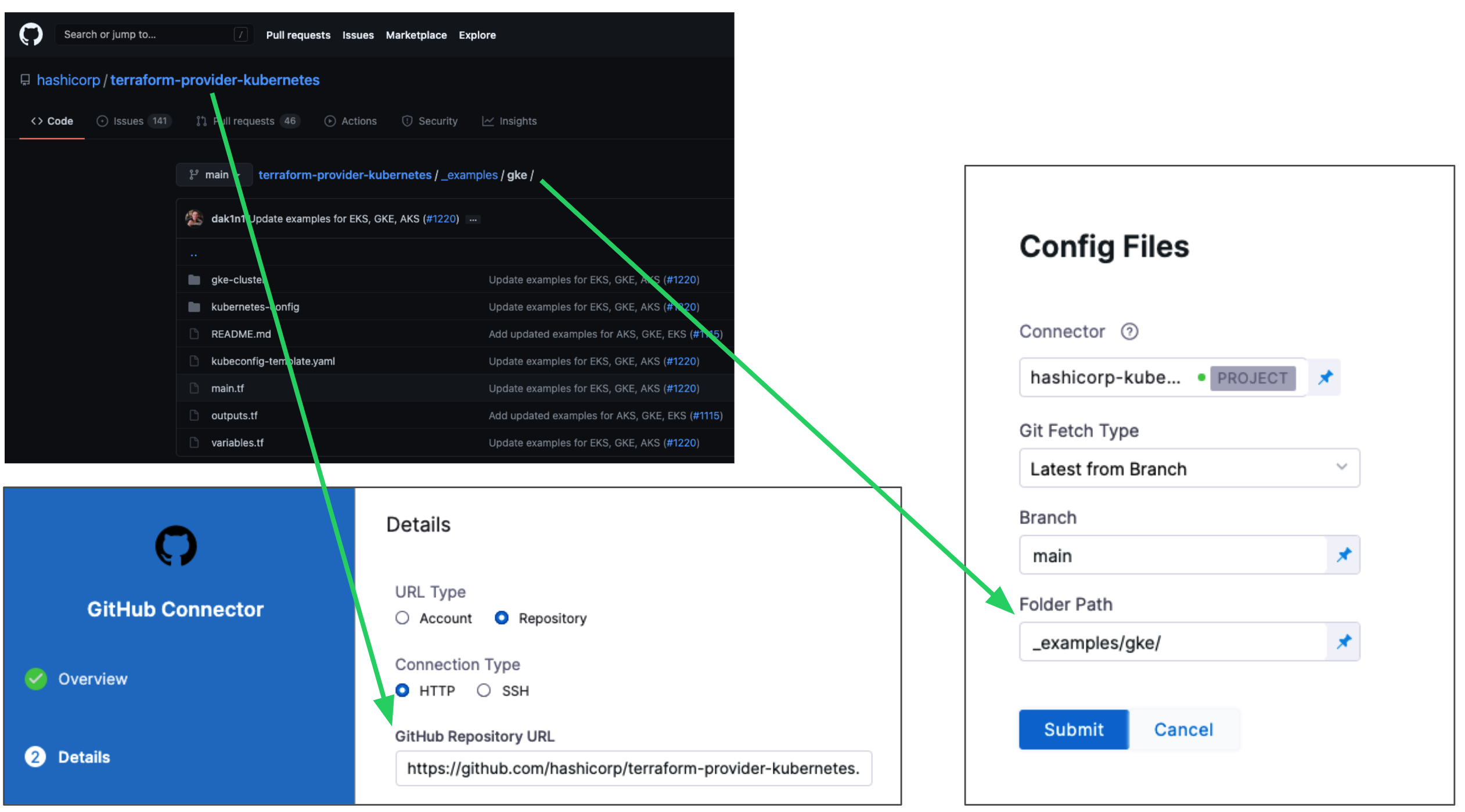
Click Submit.
Your Terraform Apply step is now ready. You can now configure a Terraform Destory or Rollback step that can use the Terraform script from this Terraform Apply step.
The following sections cover common Terraform Apply step options.
Artifactory
See Artifactory Connector Settings Reference.
AWS S3
-
In Region, select the region where your bucket is stored.
-
In Bucket, select the bucket where your Terraform files are stored (all buckets from the selected region that are available to the connector will be fetched).
-
In Folder Path, enter the path from the root of the repo to the folder containing the script.
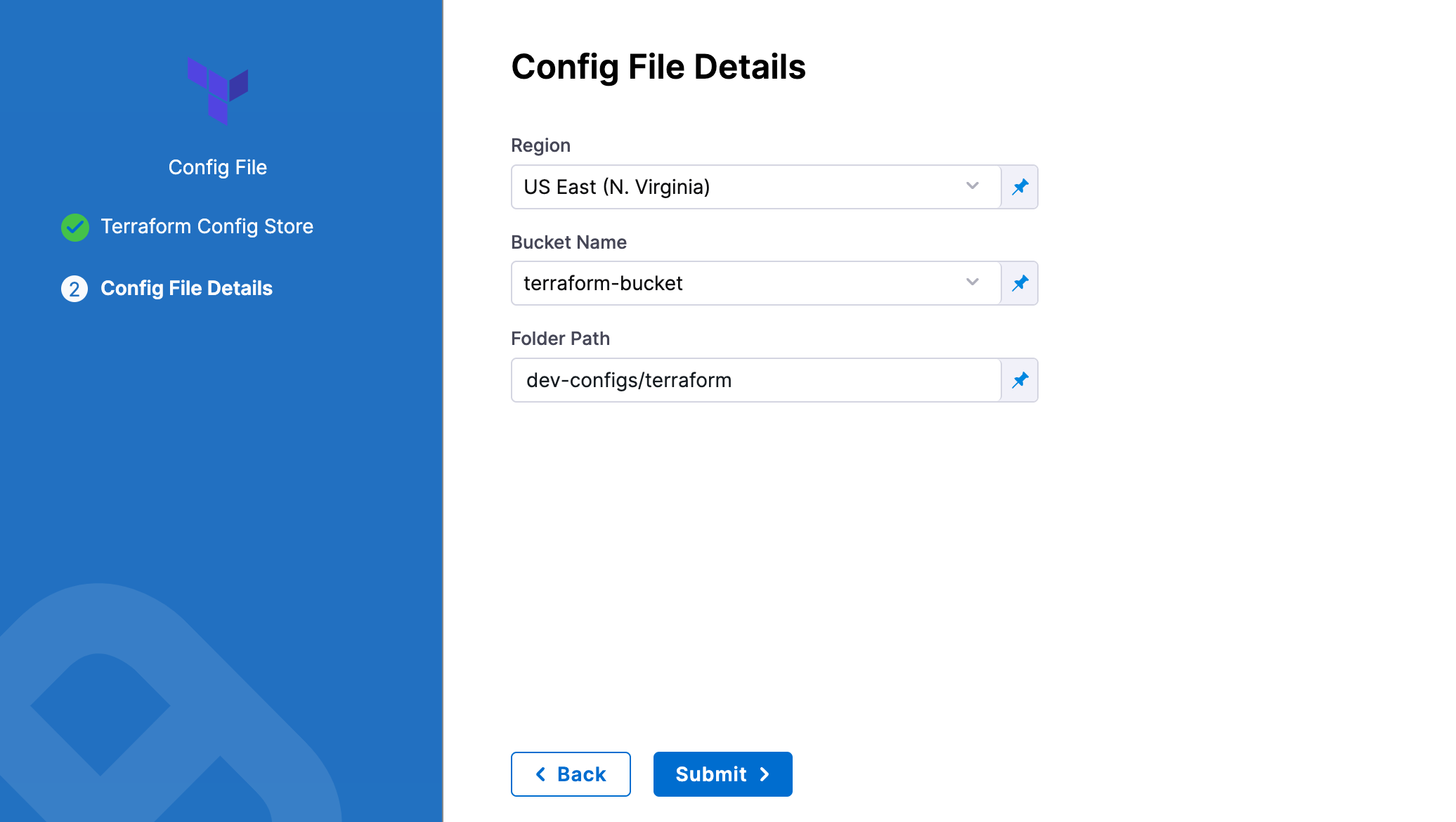
Harness will fetch all files from specified folder.
Source module
When you set up the file repo in Configuration File Repository, you use a Harness Connector to connect to the repo where the Terraform scripts are located.
Some scripts will reference module sources in other repos and Harness will pull the source code for the desired child module at runtime (during terraform init).
In Source Module, you can select Use Connector credentials to have Harness use the credentials of the Connector to pull the source code for the desired child module(s).
If you do not select Use Connector credentials, Terraform will use the credentials that have been set up in the system.
The Use Connector credentials setting is available to Harness Git Connectors using SSH authentication or HTTPS.
When configuring the SSH key for the connector, exporting an SSH key with a passphrase for the module source is not supported. Configure an SSH Key without the passphrase.
Here is a syntax example to reference the Terraform module using the SSH protocol:
source = "git@github.com:your-username/your-private-module.git"
Here is a syntax example to reference the Terraform module using the HTTPS protocol:
source = "git::https://github.com/your-organization/your-private-module.git"
The ability to authenticate with HTTPS is new! The Minimum required delegate version is: 83401. Here is a demo on its functionality:
Workspace
Harness supports Terraform workspaces. A Terraform workspace is a logical representation of one your infrastructures, such as Dev, QA, Stage, Production.
Workspaces are useful when testing changes before moving to a production infrastructure. To test the changes, you create separate workspaces for Dev and Production.
A workspace is really a different state file. Each workspace isolates its state from other workspaces. For more information, see When to use Multiple Workspaces from Hashicorp.
Here's an example script where a local value names two workspaces, default and production, and associates different instance counts with each:
locals {
counts = {
"default"=1
"production"=3
}
}
resource "aws_instance" "my_service" {
ami="ami-7b4d7900"
instance_type="t2.micro"
count="${lookup(local.counts, terraform.workspace, 2)}"
tags {
Name = "${terraform.workspace}"
}
}
In the workspace interpolation sequence, you can see the count is assigned by applying it to the Terraform workspace variable (terraform.workspace) and that the tag is applied using the variable also.
Harness will pass the workspace name you provide to the terraform.workspace variable, thus determining the count. If you provide the name production, the count will be 3.
In the Workspace setting, you can simply select the name of the workspace to use.
You can also use a stage variable in Workspace.
Later, when the Pipeline is deployed, you specify the value for the stage variable and it is used in Workspace.
This allows you to specify a different workspace name each time the Pipeline is run.
You can even set a Harness Trigger where you can set the workspace name used in Workspace.
Connector Credentials
You can use a connector to authenticate with the target cloud provider. This is an optional configuration that takes the connector reference. The Terraform step uses this connector to authenticate with the cloud provider targeted for infrastructure provisioning.
This connector configuration is available in the Terraform Apply step when the Configuration Type is set to Inline.
AWS Connector
This feature requires Harness Delegate version 81202. This feature is available only to paid customers. Contact Harness Support to enable the feature.
You can use an AWS connector to have the Terraform Plan and Apply step assume a role to perform infrastructure provisioning. It's an optional configuration that takes the AWS connector, a region and Role ARN. The Terraform step uses these parameters to authenticate the AWS account targeted for infrastructure provisioning.
By default, AWS assumes the role session duration as 900 seconds. To increase the AWS role session duration, a built-in environment variable, HARNESS_AWS_ASSUME_ROLE_DURATION is introduced, which can be used to override the assume role session duration. HARNESS_AWS_ASSUME_ROLE_DURATION is designed for use in Terraform steps in the environment variable section. The value must be set in seconds. This new environment variable requires Harness Delegate version 82700.
When configured the optional configuration for AWS Connector these fields can be passed as a fixed value, runtime input, or an expression
Sample YAML
- step:
type: TerraformApply
name: Apply
identifier: Apply
spec:
provisionerIdentifier: provision
configuration:
type: Inline
spec:
workspace: <+input>
configFiles: {}
providerCredential:
type: Aws
spec:
connectorRef: <+input>
region: <+input>
roleArn: <+input>
timeout: 10m
Terraform variable files
You can specify Terraform variables inline and fetch remote variable files during run time. For more information, go to Specify Terraform variables.
Git providers
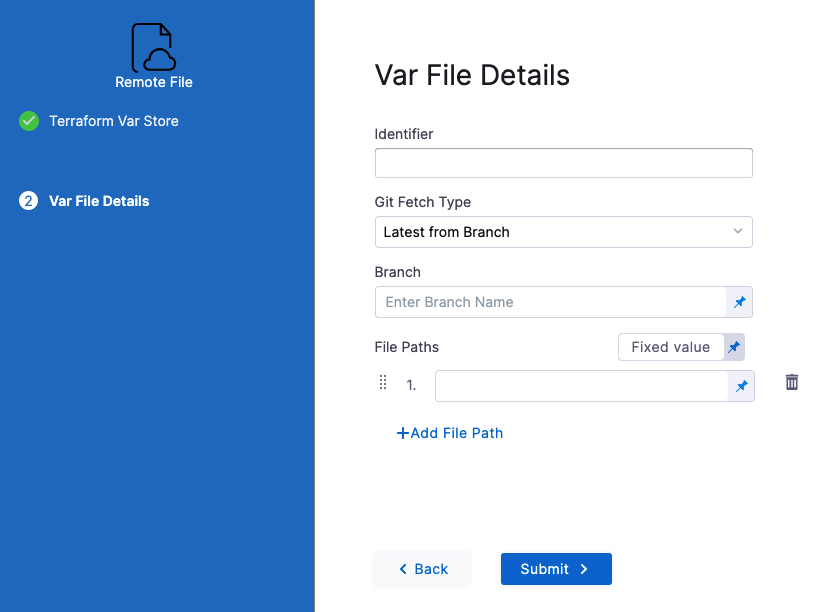
In Identifier, enter an identifier so you can refer to variables using expressions if needed.
In Git Fetch Type, select Latest from Branch or Specific Commit ID.
In Branch, enter the name of the branch.
In File Paths, add one or more file paths from the root of the repo to the variable file.
Click Submit. The remote file(s) are added.
Artifactory
See Artifactory Connector Settings Reference.
S3 provider
In Identifier, enter an identifier, so you can refer to variables using expressions if needed.
In Region, select the region where your bucket is stored.
In Bucket, select the bucket where your Terraform var files are stored (all buckets from the selected region that are available to the connector will be fetched).
In File Paths, add one or more file paths from the root of the bucket to the variable file.
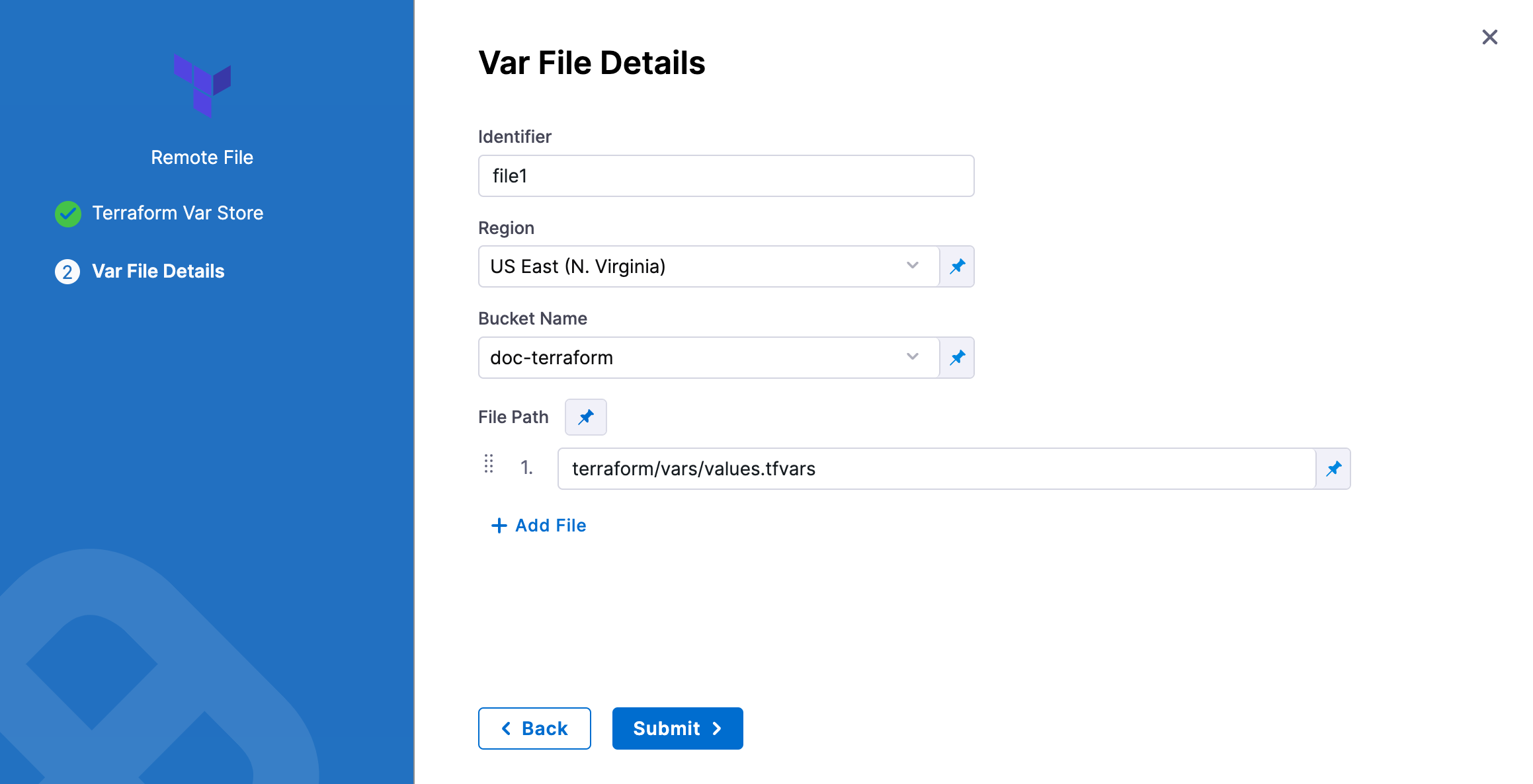
Click Submit. The remote file(s) are added.
Azure Connector
Harness Terraform steps now support authenticating with Azure using Azure connectors for target provisioning. This enables seamless integration with Azure infrastructure when running Terraform Plan, Apply, and Destroy steps with inline Terraform configuration.
Key Features
- Azure Connector support: Authenticate Terraform operations using Azure connectors configured in Harness.
- Authentication methods: Manual credentials, Delegate-based credentials, OIDC token-based authentication and Certificate-based authentication are supported.
- Additional options: Default configuration can be overridden with environment variables like ARM_TENANT_ID and ARM_MSI_ENDPOINT for advanced scenarios.
For more information on how to setup an Azure connector, go to Azure Connector Settings Reference.
YAML Configuration Example
Sample YAML
- step:
type: TerraformPlan
name: TerraformPlan_1
identifier: TerraformPlan_1
spec:
provisionerIdentifier: planoidc
configuration:
command: Apply
configFiles:
store:
spec:
connectorRef: githubConnector
repoName: play
gitFetchType: Branch
branch: main
folderPath: tf/azure
type: Github
providerCredential:
type: Azure
spec:
connectorRef: AzureConnector
subscriptionId: 20xxxxxx-xxxx-xxxx-xxxx-xxxxxxxxxxxx
Backend configuration
The Backend Configuration section contains the remote state values.
You can use an inline or remote state file.
Using a remote state file with Terraform Apply
- In Backend Configuration, select Remote.
- Click Specify Backend Config File
- Select your provider (GitHub, Artifactory, S3, etc.) and then select or create a Connector to the repo where the files are located. Typically, this is the same repo where your Terraform script is located, so you can use the same Connector.

Git providers
-
In Git Fetch Type, select Latest from Branch or Specific Commit ID.
-
In Branch, enter the name of the branch.
-
In File Path, add file path from the root of the repo to the backend config file.
-
Click Submit. The remote file(s) are added.
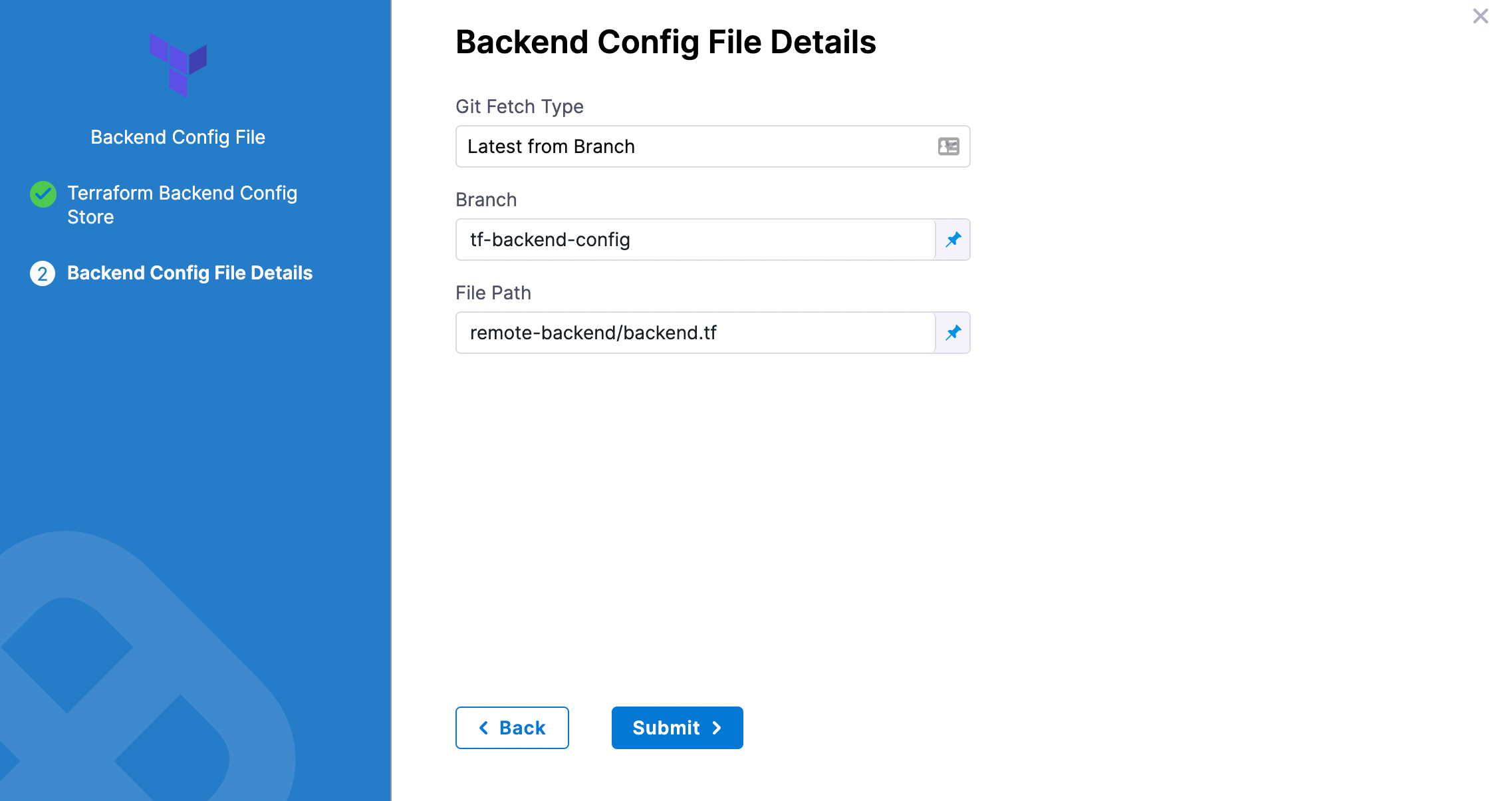
Artifactory
See Artifactory Connector Settings Reference.
AWS S3
-
In Region, select the region where your bucket is stored.
-
In Bucket, select the bucket where your backend config file is stored (all buckets from the selected region that are available to the connector will be fetched).
-
In File Path, add file path from the root of the bucket to the backend config file.
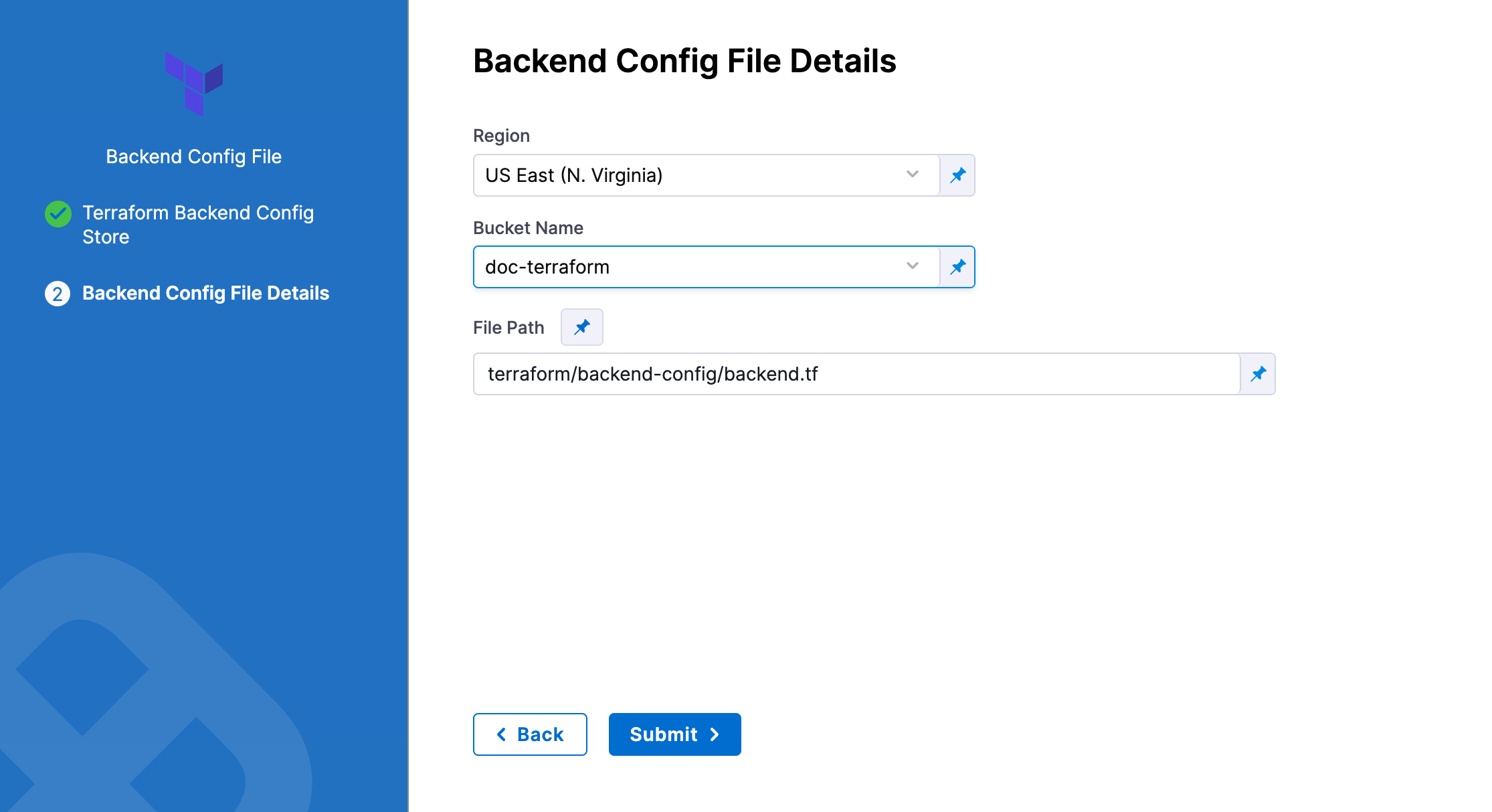
You can also use files in the Harness File Store.
To use the same remote state file set in the Terraform Plan step, Terraform Apply steps must use the same Provisioner Identifier.
For an example of how the config file should look, please see Backend Configuration from HashiCorp.
Here's an example.
main.tf (note the empty backend S3 block):
variable "global_access_key" {type="string"}
variable "global_secret_key" {type="string"}
variable "env" {
default= "test"
}
provider "aws" {
access_key = "${var.global_access_key}"
secret_key = "${var.global_secret_key}"
region = "us-east-1"
}
resource "aws_s3_bucket" "bucket" {
bucket = "prannoy-test-bucket"
}
terraform {
backend "s3" {
}
}
backend.tf:
access_key = "1234567890"
secret_key = "abcdefghij"
bucket = "terraform-backend-config-test"
key = "remotedemo.tfstate"
region = "us-east-1"
Using inline state with Terraform Apply
Enter values for each backend config (remote state variable).
For example, if your config.tf file has the following backend:
terraform {
backend "gcs" {
bucket = "tf-state-prod"
prefix = "terraform/state"
}
}
In Backend Configuration, you provide the required configuration variables for the backend type.
For a remote backend configuration, the variables should be in .tfvars file.
Example:
bucket = "tf-state-prod"
prefix = "terraform/state"
In your Terraform .tf config file, only the definition of the Terraform backend is required:
terraform {
backend "gcs" {}
}
See Configuration variables in Terraform's gcs Standard Backend doc.
Targets
You can use the Targets setting to target one or more specific modules in your Terraform script, just like using the terraform plan -target command. See Resource Targeting from Terraform.
You simply identify the module using the standard format module.name, like you would using terraform plan -target="module.s3_bucket".
If you have multiple modules in your script and you don't select one in Targets, all modules are used.
Environment variables
If your Terraform script uses environment variables, you can provide values for those variables here.
For example:
TF_LOG_PATH=./terraform.log
TF_VAR_alist='[1,2,3]'
You can use Harness encrypted text for values. See Add Text Secrets.
Terraform Apply step output
Terraform Apply step output is available after the Terraform Apply step has completed. The output can be exposed to other steps or resources in Harness.
You can find the output in the Output area of the step. To use the output, copy the expression path to the output key as shown in the following image:

The expression is of the form <+pipeline.stages.stage-provisioning.spec.execution.steps.TerraformApply_5.output.TEST_OUTPUT_NAME1>
When you use this expression in another step, the expression resolves to its value.
Encrypt the Terraform Apply JSON outputs
The Encrypt json output setting encrypts the Terraform JSON output as a Harness secret. Only Harness Secret Manager is supported.
The secret is ephemeral and is created and deleted during the execution of the pipeline. After execution completes, the secret is deleted.
The secret is stored in the Secrets list in Harness, at the project level.
You can use an expression to retrieve the secret and its Terraform JSON output during pipeline execution.
This secret expression can be used in other steps that can parse, validate, and extract the required output values from the JSON.
In Encrypt json output, select or create a secret manager to use for encryption/decryption.
To obtain the expression, do the following:
- In a pipeline execution that uses this feature, select the Terraform Apply step.
- In the step details, select Output.
- In Output Name, locate
TF_JSON_OUTPUT_ENCRYPTED. - Copy the expression. When you paste it, it will look something like
<+pipeline.stages.stage1.spec.execution.steps.TerraformApply_1.output.TF_JSON_OUTPUT_ENCRYPTED>.
Do not use the Output Value, for example <+secrets.getValue("terraform_output_df1ds123331123122123_LYF5b3")>.
A secret is masked in Harness logs, but you can write it to a file like this:
cat <<EOF > apply_outputs.json
<+pipeline.stages.stage1.spec.execution.steps.TerraformApply_1.output.TF_JSON_OUTPUT_ENCRYPTED>
EOF
Above example will pass the content of Terraform apply outputs as-is into the file including quotes, etc.
Here's an example of decrypted Terraform JSON output:
{
"test-output-name1": {
"sensitive": false,
"type": "string",
"value": "test-output-value1"
},
"test-output-name2": {
"sensitive": false,
"type": "string",
"value": "test-output-value2"
}
}
Handling Sensitive Terraform Outputs
To extract specific values from the encrypted Terraform output, users can use tools like jq to parse and retrieve individual values from the JSON output.
To parse a file using the jq tool, its content must be in a valid JSON format. jq binary should be installed on the delegate.
For example, use the following command to extract the value for test-output-name1:
jq '.["test-output-name1"].value' file.json
Skip state storage
The following feature requires a minimum Harness Delegate version of 812xx.
While running Terraform commands on the delegate, Harness by default will try to detect if there is a local state file in the Terraform working directory.
If local state file is identified, at the end of the execution it is saved on Harness storage with a key based on the provisioner identifier.
That state file is downloaded in the Terraform working directory for subsequent executions, and the updated state is uploaded after execution ends.
This method allows the maintaining of the state of the infrastructure even if there is no Terraform backend configured.
This is more for testing purposes. For production environments, Harness advises you configure a backend in your Terraform config files. For information, go to Backend Configuration.
With the Skip state storage option enabled, Harness allows you to skip the local state upload and download operations mentioned above.
This option makes is useful only if you do not have a Terraform backed configured in your Terraform config files. If you have a Terraform backed configured, then the Terraform CLI will not create any local state files.
If the Terraform Apply step is configured to skip state storage, and there is no backend configured in your Terraform files, you should not add a rollback step, as this is an invalid setup. Rollback is impossible if there is no state file.
Create remote workspace with prefix
This setting is only available when the Configuration Type is Inline.
This option is available only on delegate version 86400 or later.
When using a remote backend with a workspace prefix, Terraform does not automatically create the workspace if it doesn’t already exist. This can cause pipeline failures with errors like:
Error: Currently selected workspace "my-app-dev" does not exist
To address this, Harness provides the Create remote workspace with prefix option. When this option is enabled:
- If the remote workspace does not exist, Harness automatically creates it and continues the execution.
- If the remote workspace does exist, Harness exports it to the
TF_WORKSPACEenvironment variable so Terraform uses it. - If both the step configuration and environment variable specify a workspace, the step configuration takes precedence.
To enable automatic workspace selection when a workspace is configured in the step settings, this flag must be enabled.
If you prefer not to use this flag, you can manually configure the workspace using the TF_WORKSPACE environment variable.
Rollback does not delete workspaces created using this option. Workspace cleanup must be handled manually.
This is how the YAML would look like
- step:
type: TerraformApply
name: Terraform Apply
identifier: Terraform_Apply
timeout: 10m
spec:
provisionerIdentifier: test
configuration:
type: Inline
createRemoteWorkspaceWithPrefix: true
spec:
configFiles: {}
Command line options
This setting allows you to set the Terraform CLI options for Terraform commands depending on the Terraform step type. For example: -lock=false, -lock-timeout=0s.
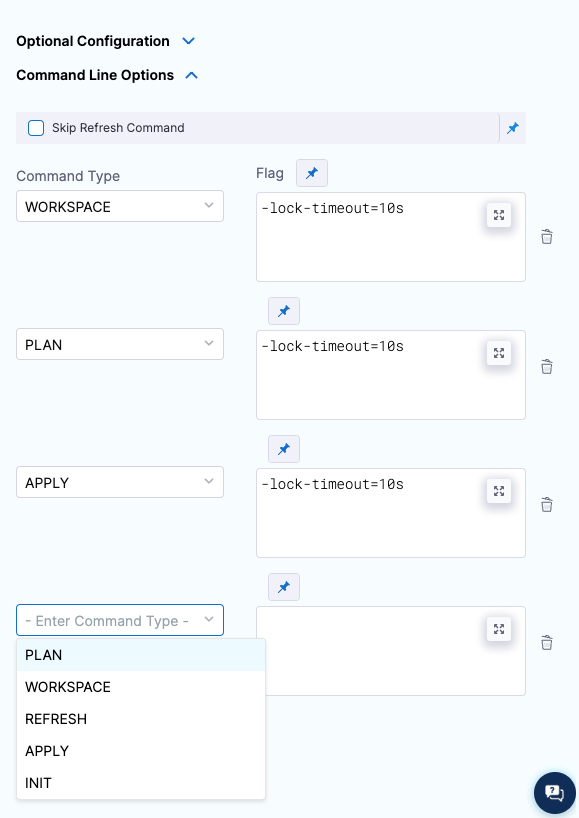
Skip Terraform refresh
Terraform refresh command won't be running when this setting is selected.
Working directory cleanup
Each Terraform step runs in a specific working directory on the delegate.
The Terraform working directory is located at /opt/harness-delegate/./terraform-working-dir/.
To that directory path, Harness adds additional directories that are named after the organization, account, project, and provisionerId (from the step) such that the final working directory is /opt/harness-delegate/./terraform-working-dir/org-name/account-name/project-name/provisionerId/.
In this final working directory, Harness stores the Terraform configuration and all fetched files such as var-files and backend-config.
Once the Terraform step execution is complete, Harness cleans up the main working directory /opt/harness-delegate/./terraform-working-dir/.
If you generate any local resources on the delegate in the directory where Terraform configurations are located, those resources are also removed. If you need those resources, make sure to generate them outside the Terraform working directory.
Advanced settings
In Advanced, you can use the following options: